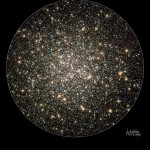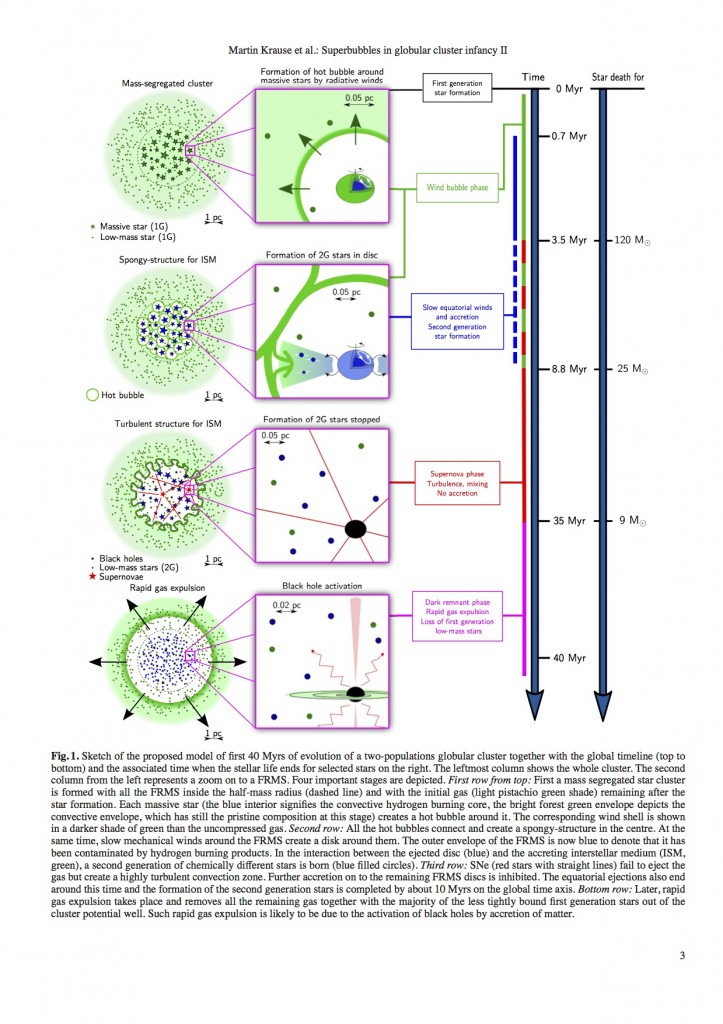Globular clusters

ISSI Team 271 Massive star clusters across the Hubble Time
Our Recent Papers on Globular Clusters and Massive Star Clusters (peer review journals only)
(2018) Concurrent formation of supermassive stars and globular clusters: Implications for early self-enrichment - Gieles, Charbonnel, Krause, Hénault-Brunet, Agertz, Lamers, Bastian, Gualandris, Zocchi, Petts (2018 MNRAS in press)
(2017) Revisiting nucleosynthesis in globular clusters. The case of NGC 2808 and the role of He and K – Prantzos, Charbonnel & Iliadis (2017 A&A 608 A28)
(2017) Sodium abundances of AGB and RGB stars in Galactic globular clusters II. Analysis and results of NGC 104, NGC 6121 and NGC 6809 – Wang, Primas, Charbonnel et al. (2017 A&A 607 A135)
(2017) Evolution of long-lived globular cluster stars. IV. Initial helium content and white-dwarf properties – Chantereau, Charbonnel & Meynet (2017 A&A 602 A13)
(2017) Are Galactic globular cluster AGB stars rich or poor in Sodium? Sodium abundance of AGB and RGB stars in NGC 2808 – Wang, Primas, Charbonnel et al. (2017 Formation, evolution, and survival of massive star clusters, Proceedings of the International Astronomical Union, IAU Symposium, Volume 316, pp. 361-362)
(2017) Globular clusters and the evolution of their multiple stellar populations – Chantereau, Charbonnel & Meynet (2017 Formation, evolution, and survival of massive star clusters, Proceedings of the International Astronomical Union, IAU Symposium, Volume 316, pp. 328-333)
(2017) Young and old massive star clusters and their stellar populations – Theoretical challenges for the next decade – Charbonnel (2017 Formation, evolution, and survival of massive star clusters, Proceedings of the International Astronomical Union, IAU Symposium, Volume 316, pp. 1-8)
(2017) Formation, evolution, and survival of massive star clusters – Charbonnel & Nota (Proceedings of the International Astronomical Union, IAU Symposium, Volume 316)
(2016) Multiple Stellar Populations and Their Evolution in Globular Clusters: A Nucleosynthesis Perspective – Charbonnel (2016, EES2015, EAS Publications Series, Volume 80-81, 2016, pp.177-226)
(2016) Stellar Clusters: Benchmarks of Stellar Physics and Galactic Evolution – EES2015 – Moraux, Lebreton, Charbonnel (2016, EES2015, EAS Publications Series, Volume 80-81, 2016)
(2016) Did globular clusters contribute to the stellar population of the Galactic halo? – Charbonnel & Krause (2016, The General Assembly of Galaxy Halos: Structure, Origin and Evolution, Proceedings of the International Astronomical Union, IAU Symposium, Volume 317, pp. 104-109)
(Sept 2016) Multiple stellar populations and their evolution in globular clusters – A nucleosynthesis perspective – Charbonnel (2016, Ecole Evry Schatzman 2015 “Stellar clusters – Benchmarks for stellar physics and galactic evolution, EAS Publication Series, Vol.80-81)
(August 2016) Evolution of long-lived globular cluster stars. III. Effect of the initial helium spread on the position of stars in a synthetic Hertzsprung-Russell diagram - Chantereau, Charbonnel & Meynet (2016, A&A, 592, A111)
(July 2016) No evidence for younger stellar generations within the intermediate-age massive clusters NGC 1783, NGC 1806 and NGC 411 – Cabrera-Ziri et al. (2016, MNRAS, 459, 4218)
(July 2016) Sodium abundances of AGB and RGB stars in Galactic globular clusters. I. Analysis and results of NGC 2808 – Wang et al. (2016, A&A, 592, A66)
(May 2016) Atomic diffusion and mixing in old stars. VI. The lithium content of M30 – Gruyters et al. (2016, A&A, 589, A61)
(March 2016) Gas expulsion in massive star clusters? Constraints from observations of young and gas-free objects – Krause, Charbonnel, Bastian & Diehl (2016, A&A, 587, A53)
(Feb 2016) Evolution of long-lived globular cluster stars. II. Sodium abundance variations on the asymptotic giant branch as a function of globular cluster age and metallicity – Charbonnel & Chantereau (2016, A&A, 586, A21)
(January 2016) Stellar astrophysics: The mystery of globular clusters – Nota & Charbonnel (2016, Nature, 529, 7587, 473)
(June 2015) Evolution of long-lived globular cluster stars. I. Grid of stellar models with helium enhancement at [Fe/H] = -1.75 – Chantereau, Charbonnel & Decressin (2015, A&A, 578, A117)
(Oct 2014) Gemini spectroscopy of the outer disk star cluster BH176 – Sharina et al. (2014, A&A, 570, A48)
(Sept 2014) Are there any first generation stars in globular clusters today? – Charbonnel et al. (2014, A&A 569, Letter 6)
(Sept 2013) Why the globular cluster NGC 6752 contains no sodium-rich second-generation AGB stars – Charbonnel et al. (2013, A&A 557, Letter 17)
(April 11, 2013) Press release on
The turbulent youth of globular clusters
- Communiqué de presse UniGe
- Communiqué de presse CNRS
- MPE press release (in english)
- MPE press release (in german)
- Futura-Sciences
Conferences
IAU Symposium 316 Formation, evolution, and survival of massive star clusters (Honolulu, Hawaï, August 3-7, 2015)
SNFS projects
SNSF project 169125 Globular cluster archeology (2016 – 2019)
SNSF project 159543 Multiple stellar populations in massive star clusters – Formation, evolution, dynamics, impact on galactic evolution (2015 – 2016)
SNSF project 140346 New perspectives on the chemical and dynamical evolution of globular clusters in light of new generation stellar models (2012 – 2015)
Which stars did contribute to the multiple stellar population phenomenon in Globular Clusters?
In 2016, we have strongly revised the scenario for the possible contribution of massive stars in the evolution of globular clusters, taking into account new and important constraints coming from young massive star clusters. See Gas expulsion in massive star clusters? Constraints from observations of young and gas-free objects – Krause, Charbonnel, Bastian & Diehl (2016, A&A, 587, A53)
A review of the recent (2016) developments is presented in Charbonnel (2016, Ecole Evry Schatzman 2015 “Stellar clusters – Benchmarks for stellar physics and galactic evolution, EAS Publication Series, in press).
“Since 2007, our team has proposed, developped, and broadened an original scenario
- the so-called “Wind of Fast Rotating Massive Stars” (FRMS) scenario -
in which fast-rotating massive stars play a key role in the formation of multiple populations in globular clusters and in shaping their chemical properties. This scenario is based on state-of-the art models of rotating stars developed by the Geneva stellar evolution group at large. It opens new exciting perspectives and calls for major revisions of many of the currently held concepts regarding the role massive stellar clusters play in the assembly and evolution of galaxies in a cosmological context. However important questions remain to be addressed, both theoretically and observationally. This is the aim of one of our main projects, which benefits from a broad and well-established international network of collaborations with some of the best world specialists working on theoretical stellar and interstellar matter hydrodynamics, numerical multi-dimensional simulations, galactic chemical evolution, spectroscopic analysis, and N-body simulations.”
(From C.Charbonnel FNS grant application)
The figure below is a ketch of the general model we propose for the first 40 Myrs of evolution of a two-populations globular cluster together with the global timeline (top to bottom) and the associated time when the stellar life ends for selected stars on the right.
(Figure taken from Krause, Charbonnel, Decressin, Meynet, Prantzos, 2013)
